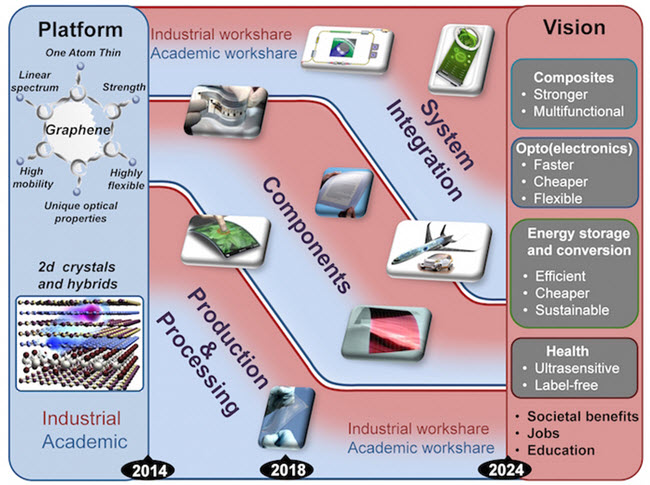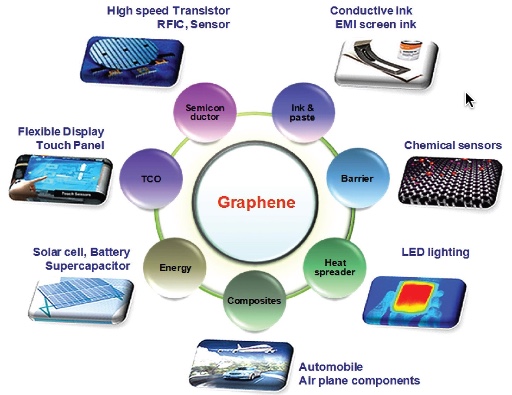European roadmap for graphene science and technology published
February 24, 2015

Roadmap for graphene and 2d materials science and technology (credit: Graphene Flagship)
In an open-access paper published today in the Royal Society of Chemistry journal Nanoscale, more than 60 academics and industrialists lay out a science and technology roadmap for graphene, related two-dimensional crystals, other 2d materials, and hybrid systems based on a combination of different 2d crystals and other nanomaterials.
The roadmap covers the next 10 years and beyond, intended to guide the research community and industry toward the development of products based on graphene and related materials.
The project started in October 2013, when academia and industry came together to form the Graphene Flagship, now with 142 partners in 23 countries, and a growing number of associate members.

Graphene applications (credit: Graphene Flagship)
Graphene and related materials are expected to revolutionize the fields in which they are applied, and they have the potential to become the materials of the 21st century. They will supplement and at times replace existing substances in a range of applications. For example, graphene could be integrated into silicon photonics, exploiting established technology for constructing integrated circuits.
“The roadmap forms a solid foundation for the graphene community in Europe to plan its activities for the coming years,” says Jari Kinaret, director of the Graphene Flagship. “It is not a static document, but will evolve to reflect progress in the field, and new applications identified and pursued by industry.”
The roadmap highlights three broad areas of activity: identify new layered materials, assess their potential, and develop reliable, reproducible and safe means of producing them on an industrial scale.
Eleven science and technology themes are identified and addressed in the roadmap: fundamental science, health and environment, production, sensors, flexible electronics, energy conversion and storage, composite materials, and biomedical devices, and electronic devices, including spintronics, photonics and optoelectronics.
The author note that a recent independent assessment has confirmed that the Graphene Flagship is firmly on course, with with hundreds of research papers, numerous patents and marketable products to its name.
Roadmap timelines predict that, before the end of the 10-year period of the flagship, products will be close to market in the areas of flexible electronics, composites, and energy. They also hope to see advanced prototypes of silicon-integrated photonic devices, sensors, high-speed electronics, and biomedical devices.
Abstract of Science and technology roadmap for graphene, related two-dimensional crystals, and hybrid systems
We present the science and technology roadmap (STR) for graphene, related two-dimensional (2d) crystals, and hybrid systems, targeting an evolution in technology, with impacts and benefits reaching into most areas of society. The roadmap was developed within the framework of the European Graphene Flagship and outlines the main targets and research areas as best understood at the start of this ambitious project. In this document we provide an overview of the key aspects of graphene and related materials (GRMs), ranging from fundamental research challenges to a variety of applications in a large number of sectors, highlithing the roadmap to take GRMs from a state of raw potential to a point where they might revolutionize multiple industries: from flexible, wearable and transparent electronics to high performance computing and spintronics.